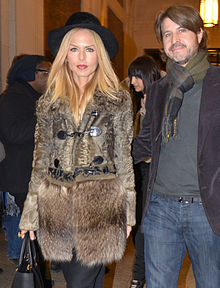Fur ingredient deal
- Sub-warehouse of a fur ingredient store
A fur ingredient store , in Austria fur accessories store , is a wholesaler and supplier for the fur processing trades, especially for the furriers and the fur industry . The factories are characterized by a wide range of stocks of all the direct fur ingredients required in the fur-processing industry , as well as the chemicals and tools used in the industry. In the past it was mostly represented by travelers.
To a lesser extent, the fur supplies store also keeps tailoring supplies in stock, just as the tailor supplies and milliner supplies stores often have a selection of furrier accessories. In addition, products for the leather clothing manufacturing companies are offered.
history
In 1711 the Leipzig furriers were forbidden to keep fur ingredients in stock, that is, trimmings , buttons, needles, threads, fabrics, gold wire and silver wire. These ingredients could be bought from six furrier colleagues.
When the middle of the 19th century began to wear furs with the hair facing outwards, there was an increased need for special fur accessories. Up to now, an extraordinarily large selection of different accessories for the fur trimmings was needed, but now the most important thing is ingredients for fur jackets and coats. The furs were pricked with linen binding fabrics to prevent tearing and with padding to keep them warm. Special, stable fur silks were fed in, for which two specialty silk weaving mills were set up in Krefeld. the company G. Hollender Sons (1842) and Peter Bircks & Cie. (1863). The usual buttons or fur buttons with a wooden core were used as closures. Wooden molds were also needed for the heads of the very fashionable fur necklaces , for blocking the sleeve and fashionable fur caps and hats.
A few fur wholesalers began to offer fur ingredients in addition to their range of fur through their traveling representatives. Fur became so fashionable at the beginning of the 20th century that it was worthwhile for some smaller companies to specialize entirely in accessories and to open a fur ingredient store.
While the furrier of the Middle Ages mainly made inner linings and trimmings of winter fabric clothing, in the 20th century he developed more and more into a fashion-making craftsman, similar to the tailor . The tools of the trade were refined. Previously, if he tensed his skins and the sewn fur linings with a hammer and nails, he now used a pair of pliers and extra nails. Skinning Knife took a contoured shape to, rolling and stretching woods used since the soft rubbing of the leather. Urban furriers no longer cut the knocking pieces for knocking out the furs themselves. Chemistry develops special fats to keep fur leather soft and stabilize and luster to improve hair fall. Many other ingredients and aids were added, which make a central supplier trade with permanent storage useful to this day. The main advantage of a middleman is that he supplies the materials in small quantities or quantities that are tailored to the needs, in contrast to manufacturers who often only sell larger quantities.
The tobacco goods commissioner Philipp Manes , murdered in the Auschwitz concentration camp , reported that his father was already working as a representative for the Leipzig and Berlin fur ingredients industry in Berlin around 1900. He mentioned the two companies Karl Veith and Leo Nomis , which owed their rise to Mane's father. Later the fur weaving company Peter Bircks & Cie. from Krefeld added "who only made their products for furriers".
In the fur directory of 1938 for the fur center of Leipziger Brühl and the center of fur clothing in Berlin, the fur ingredient dealers Otto Lösche and Krock & Pohling for Leipzig are listed, both on Reichsstraße, for Berlin, Paul Kießling , SW 68, Schützenstraße 33 (expired 1984), Fritz Quiess , C2, Niederwallstraße 21 and one number further, Anna Will , Niederwallstraße 22, still under the heading “Pelzfurnituren”. It was the able Anna Will, according to Philipp Manes, who was the first to produce muff bags before she later incorporated an ingredients and fur business.
In 1953, Winckelmann , who has been the address book of the fur industry for decades and has appeared in many national editions, recorded ten companies for fur ingredients and furrier tools for the Federal Republic of Germany, as well as special suppliers for lining materials and yarn, chemical products, buttons and needles, wickerwork , moth protection bags and machines . After a probably unique boom in fur clothing, there were around 35 companies in 1981, some with warehouses in several cities.
Fur ingredients companies settled in and around the wholesale outlets for fur skins, be it in New York between 24th and 31st Street, until the Second World War at Leipziger Brühl and after the war in the fur trading center of Frankfurt am Main, Niddastraße . Not only the tobacco merchants were represented there, but also many furrier companies that produced semi-finished fur products or worked for fur clothing. There were seven fur ingredient stores on Niddastrasse alone.
After the Second World War, the Düsseldorf-based company Karschierow & Barkowsky , which was founded in 1946 and soon trading as Gustav Karschinierow , developed into the largest supplier of fur ingredients. A branch was located in Karlstrasse 12, which is adjacent to Niddastrasse. After the death of his father Gustav Karschinierow (* 1906 in Stuttgart), his son Uriel Karschinierow (* 1938; † 2011) continued the company. At the worst possible time, he expanded the company. He took over the ailing fur silk weaving mill Peter Bircks & Cie. and had a new warehouse built. At that time, fur sales began to stagnate, at the same time the furriers largely stopped working with classic fur silks and instead turned to fashionable synthetics from the textile industry. In the trend to make furs lighter and lighter, fewer and fewer intermediate materials such as pricking fabrics or wadding were used. Uriel Karschinierow had to file for bankruptcy, the attempt by the employees of the former Bircks weaving mill to continue this line of business also failed. To a very small extent, Uriel Karschinierow continued to trade in fur ingredients.
In 2018 there were still three fur ingredient stores in Germany, of which H. Espey in Gladbeck in the Ruhr area is the leader. The company emerged from the continuation of M. & E. Gans , which was founded in Borken around 1924 as a wholesaler for tailoring supplies. It later moved to Gladbeck. The owners Gans were Jews, nothing more seems to be known about the type and time of handover (during the time of National Socialism?) To Heinz Espey († 1996). After Heinz Espey returned after the Second World War, the business continued under its current name. In 1978, nine commercial employees, a trainee and two assistants worked here. Around this time, the first outer materials for the outer coats for fur linings, known by the furriers as an essential part of the product, were adopted. In 1980 the company was converted into a GmbH, the managing directors were the previous employee Karl Hans Holtwiesche (until 2002) and, still further, Johannes Schroer. In October 2017, the son Carsten Schroer (* 1977) was announced as the second managing director and future successor .
In the GDR, the department supplied VEB fur accessories of VEB fur trade on Brühl to 1989, a total of 400 relevant enterprises of the GDR with processed skins and accessories, including the Leipzig space 106 private furrier and two powerful production cooperatives. It emerged from the amalgamation of the Leipzig ingredients companies F. Lösche , F. Reifferscheidt and Mrs. Ernst Wieseler , all three with their headquarters on Nikolaistraße.
Due to the considerable decline in the fur-producing craft in Europe and the possibility of online shopping, the branches or agencies mostly of German companies have disappeared not only in Germany, but also in Switzerland and Austria. In addition, not every furrier requirement is covered by the fur wholesalers. Some ingredients are sourced directly from the manufacturer by the fur processors; under certain circumstances, especially by large companies, articles that are used in large quantities.
- Sample cards of fur ingredients from the Carl Gentz ingredients store, Düsseldorf (around 1950)

Typical offer items
The main core offerings of a fur ingredient dealership are:
- Lining silk, intermediate ingredients (pricking fabric, batiste, wadding and others)
- Light outer fabrics for the covers of fur linings, often from Italian weavers
- Yarns (synthetics, silks, threads) for hand and machine
- Closures for fur and textile clothing (clips, buttons, zippers and others)
- Muff-down bags, muff-pocket inlets, muff blocks
- Necklace accessories (partly only historical): cardboard, wooden head shapes, glass eyes (formerly made by Germans from Czechoslovakia, area around Gablonz and Morchenstern, later in Austria, especially in Tyrol) round and oval, necklace clips, claws made of sheet metal or celluloid , Noses and nasal cement, trimmings, cords, chenille, steel and trimmings chains, etc.
- Chemicals (lauter shavings soaked with or without cleaning fluid, hair lustres, hair dyes, leather fats ("Kürschnermilch"), leather dyes (alcohol-soluble aniline dyes))
- Tools, including sewing needles, pins, purpose nails, purpose clips. Not only the industrial blades for skinning knives, which are widely used in the furrier trade, but also the blade holders, pliers and other furrier tools required for them come mainly from the blade city of Solingen .
- Fashionable accessories
The company Hausding & Bergmann (founded before 1919), ingredients and supplies for the fur, hat and cap industry in Pirna , Saxony, did not employ traveling agents. Instead, she sent out catalogs with her offer. In her special brochure no. 43, for example from the 1930s, for "the right thing in ingredients, tools and important furnishings as well as all indispensable aids for the workshop, shop, shop window and storage", she illustrated:
- In the Greek furrier town of Kastoria (2014)
- Muff blocks, muff-down bags, muff bags, handbags to be covered with fur, muff stands and a hand hole template as an aid for the purpose of barrel sleeves
- Fur busts for foxes, collars and capes as well as other decoration aids, a new sales stand for stranglers (small single-skin fur necklaces), fur ties, etc.
- Roll stand for furs, model "Rollflink"
- Try-on and table mirrors
- a chalk wheel
- a device for matching the hem of the coat and jacket (so-called skirt rounder) with a needle cup
- various coat hangers, fur hangers and rings
- white "work coats with fixed pockets with hand-sewn buttonholes, set up for interchangeable buttons" (white coats, the typical work clothes of the entire fur industry until the 1980s)
- Sealing pliers for sheet steel seals and seals
- Stamp hammers with interchangeable letters to identify the skins, with long pens, so no matting or tearing of the leather
- Fell receipt pad for finished goods, repair books and made-to-measure books with Manila cardboard for the workshop to copy through
- Protective bag for storing fur goods made of tough or transparent paper with a snap fastener
- a DIN RAL manager according to the regulations of the trade association for retail ( Hamax-G -leiter )
- a neatly built tool box as a lockable wall cabinet, with or without furrier tools
- and, in front of the reference to the main catalog with the actual fur ingredients, the shoulder pad "Großlaub" Achselwatt ", the stable air shoulder that meets all requirements".
Web links
Individual evidence
- ^ Paul Schöps: To the origin of the craft . Manuscript p. 92. Chapter Business of the guilds and guild members. P. 10, without specifying the primary source ( Collection G. & C. Franke ).
- ↑ a b Alexander Tuma: Pelz-Lexikon. Fur and Rauhwarenkunde, Volume XX . Alexander Tuma, Vienna 1950, p. 162–163, keyword “fur deeds” .
- ^ Philipp Manes : The German fur industry and its associations 1900-1940, attempt at a story . Berlin 1941 Volume 3. Copy of the original manuscript, p. 212 ( → table of contents ).
- ↑ News from the commercial register - deletions (HRA 10.953, last address: Kurfürstenstraße 23, Berlin 30). In: Winckelmann Pelzmarkt. No. 738, Frankfurt am Main, March 23, 1984, p. 15.
- ↑ Guide through the Brühl and the Berlin fur industry , Werner Kuhwald Verlag, Leipzig 1938, pp. 150, 156, 181, 187.
- ^ Philipp Manes : The German fur industry and its associations 1900-1940, attempt at a story . Berlin 1941 Volume 1. Copy of the original manuscript, p. 163 ( G. & C. Franke collection ).
- ↑ Sonja Gelzenleuchter: The Frankfurt Pelzviertel as an example of a monofunctional district . Diploma thesis, Darmstadt, July 1983. Table of contents.
- ^ Winckelmann Germany. Specialist address book for smoking goods and Fur industry and the furrier trade , 81st edition, 1973, p. 203.
- ↑ commons: Category: Gustav Karschinierow .
- ↑ operating documents. Accessed May 30, 2018.
- ↑ https://www.moneyhouse.de:/ Johannes Schröer from Bottrop . Last accessed June 10, 2018.
- ↑ Succession arranged - specialist wholesaler Espey sets the course for the future . In: Pelzmarkt Newsletter 10/17, October 2017, Deutscher Pelzverband e. V., Frankfurt am Main, pp. 9-10.
- ^ H. Espey on Commons .
- ↑ http://artefakte.perladesa.de/ , Leipzig - trade fair and book city. Artifacts - monuments of German history . Last modified November 7, 2016. Accessed August 3, 2017.
- ^ Paul Schöps: The fur industry of the GDR . Undated original manuscript, p. 1, G. & C. Franke collection.
- ↑ Winckelmann specialist address book of the tobacco and fur industry for Germany , 59 edition, 1950/51.
- ^ Undated catalog No. 43 (not before 1925; 1930s?) From Hausding & Bergmann, Pirna / Saxony.















